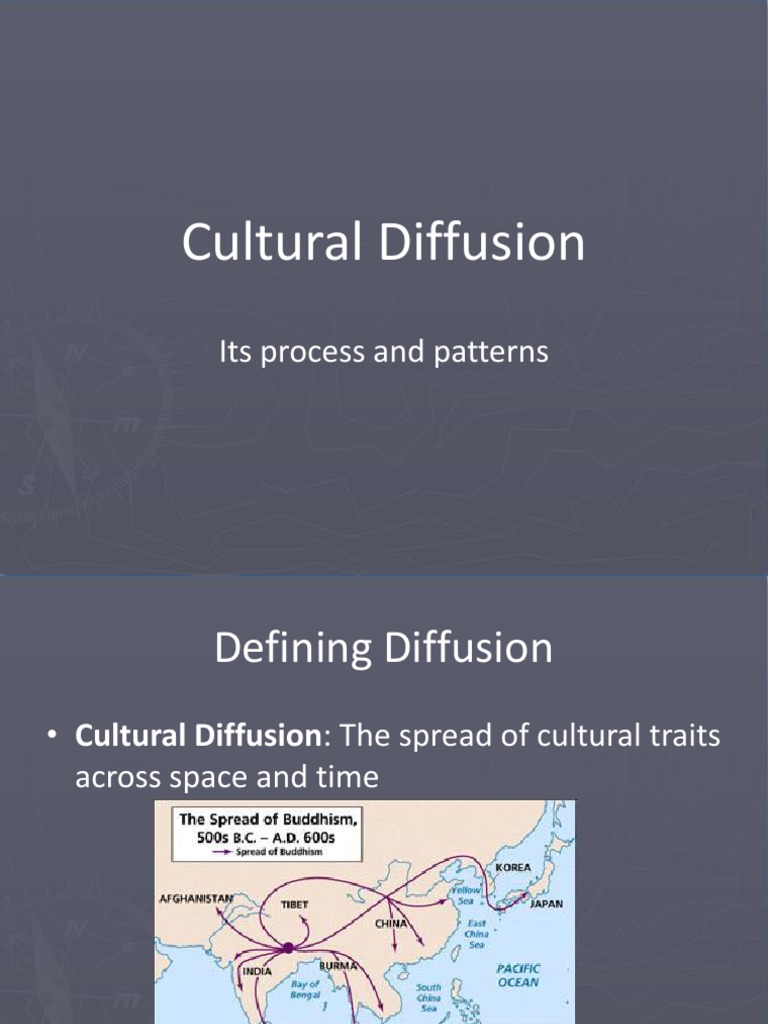Cultural diffusion represents a compelling interplay of human interactions, emphasizing the transmission of cultural beliefs, practices, and innovations across geographical boundaries. This concept elucidates how cultures influence one another over time, redefining identities, traditions, and social frameworks. Understanding cultural diffusion not only sheds light on historical phenomena but also unearths the dynamics of contemporary societal transformations. By examining its mechanisms and implications, one can appreciate the complex tapestry of global interconnections.
The foundation of cultural diffusion lies in the exchange of ideas, norms, and values. This multidimensional process can be categorized into several distinct yet interrelated types: material culture diffusion, non-material culture diffusion, and forced diffusion. Material culture diffusion pertains to the spread of tangible objects and technologies. This may include agricultural techniques, clothing styles, and architectural forms, all of which manifest in different regions due to external influence. Non-material culture diffusion, in contrast, encompasses intangible elements such as language, beliefs, and rituals. Forced diffusion often arises through conquest, colonization, or other coercive means, leading to profound alterations in indigenous cultures.
Central to understanding cultural diffusion is the concept of cultural hybridization. This process refers to the blending of diverse cultural elements to form new practices or ideologies. Cultural hybridization often emerges during periods of globalization, where cultural barriers dissolve and allow for more fluid exchanges. A quintessential example can be observed in culinary arts—where traditional dishes assimilate spices or cooking techniques from other cultures, leading to a fusion cuisine that represents a unique synthesis rather than a mere replication.
While cultural diffusion often celebrates diversity, it can also provoke significant tension. The coexistence of differing cultures within a particular space can lead to misunderstandings and cultural clashes. Such conflicts may arise from the imposition of dominant cultural norms on minority groups, potentially resulting in cultural erosion and identity crises. To counteract these effects, many advocate for cultural preservation initiatives, emphasizing the importance of maintaining traditional practices in the face of pervasive globalization.
The mechanisms of cultural diffusion can be elucidated through notable models, each illuminating various facets of this phenomenon. The most recognized model is the process of relocation diffusion, where cultural traits migrate along with groups of people. This can often be observed in the migrations caused by economic instability or environmental pressures, where displaced populations carry their customs to new locales. Contagious diffusion, another significant mechanism, describes how cultural phenomena spread rapidly through direct contact within a community. The popularity of social media platforms underscores this phenomenon, enabling ideas, trends, and socio-political movements to proliferate at an unprecedented rate.
Technological advancements have played an instrumental role in fostering cultural diffusion in modern times. The advent of the internet, for instance, has democratized access to a plethora of cultural artifacts, significantly altering how cultural products circulate. Social networking sites, blogs, and platforms devoted to multimedia sharing enable individuals to transcend geographical and temporal limitations, facilitating an unparalleled exchange of cultural expressions. Yet, while technology catalyzes cultural diffusion, it simultaneously raises questions about authenticity and appropriation. The line between appreciation and exploitation often blurs in digital spaces, prompting critical discourse surrounding the ethical consumption of culture.
It is important to ascertain the role of cultural intermediaries, such as artists, diplomats, and scholars, in the diffusion process. These individuals act as conduits for cultural exchange, skillfully navigating the intricate landscape of global cultures. Their ability to facilitate dialogues and foster mutual understanding is paramount to enhancing intercultural relations. Through collaborative projects, exhibitions, or academic exchanges, cultural intermediaries contribute to a richer, more nuanced understanding of diverse social paradigms.
The impact of cultural diffusion extends beyond mere interaction; it molds collective identities and drives socio-political movements. Consider the civil rights movement, which harnessed ideologies from various cultural contexts to advocate for social justice and equality. Through the appropriation of cultural symbols and narratives, activists were able to construct a cohesive identity that transcended racial and geographical divides. This highlights the potential for cultural diffusion to effect change, serving as a catalyst for collective consciousness and mobilization.
A vital aspect of cultural diffusion is its reciprocal nature. Cultures continuously influence and are influenced by each other, leading to ongoing evolution. This mutual exchange encourages curiosity and inquiry, fostering an intellectual environment where diverse perspectives enrich the collective experience. Embracing cultural diffusion can cultivate empathy, understanding, and respect for differences—qualities essential for navigating an increasingly interconnected world.
Evaluating the environmental ramifications of cultural diffusion is also crucial. As cultures evolve and intermingle, they adopt new perspectives toward sustainability and ecological stewardship. Indigenous practices rooted in harmony with nature can inspire global discourses on ecological responsibility. Conversely, the widespread adoption of consumer culture can exacerbate environmental degradation. Thus, recognizing these connections is imperative in promoting a more sustainable future.
The promise inherent in cultural diffusion lies in its capacity to transform societies. It subverts stagnation, encourages innovation, and fosters resilience through diversity. Through a lens of cultural diffusion, one can glean insights into the intricacies of human connection and creativity. In a world beset with challenges—socially, politically, and environmentally—cultural diffusion serves as a reminder of our shared humanity and the potential for collaborative solutions. By embracing this phenomenon, individuals and societies can embark on a journey of exploration, fostering an enriching tapestry woven from the threads of myriad cultural traditions.
